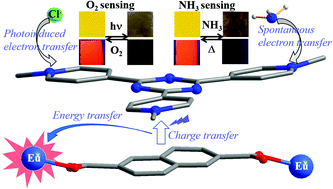Photoinduced versus spontaneous host–guest electron transfer within a MOF and chromic/luminescent response†
Abstract
A novel Eu(III) metal–organic framework (MOF) featuring 3-fold interpenetration shows multi-responsive behaviors owing to the combination of charge transfer, electron transfer, and energy transfer between different ingredients (the electron-deficient tris(pyridinium)triazine (tpt) chromophore, the electron-rich naphthalene chromophore, the Eu(III) luminophore, and the guest anion). The interframework naphthalene-to-tpt charge transfer dictated by framework interpenetration serves to sensitize the Eu(III) emission through energy transfer. The photoinduced host–guest electron transfer from the intrinsic chloride guest to tpt leads to photochromism and photoquenching of photoluminescence. The spontaneous host–guest electron transfer from extrinsic amine/ammonia to tpt allow chromic and luminescent response to ammonia and amines with size selectivity. Furthermore, the photogenerated phase shows sensitive color change and luminescence turn-on upon exposure to O2. The multi-responsive properties offer the appeal for optical switching and sensing use. The qualitative and quantitative gaseous sensing of ammonia and O2 has been demonstrated with portable and reusable MOF–polymer membranes.

- This article is part of the themed collection: 2021 Inorganic Chemistry Frontiers HOT articles


 Please wait while we load your content...
Please wait while we load your content...